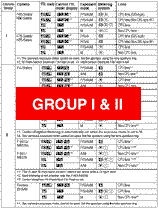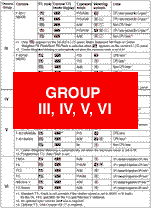Introduction
This very elegant looking Nikon speedlight was introduced in late 2004 to replace the Nikon SB-80DX AF-TTL Speedlight(2002). The emergence and wide-acceptance of Nikon digital cameras has also resulted Nikon in maintaining dual models within their AF-flash models in order to suit individual requirement for users which can be both costly and inconvenient to up keep flash for their film-based and digital AF-SLRs. The introduction of both the Nikon SB-600 AF-TTL speedlight and this high performance SB-800 have streamlined the Nikon flash product line in order to tackle the incompatibility issues between the two format of film as well as digital family of AF-SLRs.
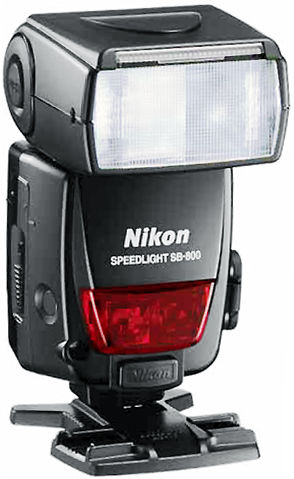 |
Both the Nikon speedlights are designed to be compatible with both digital and film SLR cameras; the auto flash control is now set to match the camera body: i-TTL Balanced Fill-Flash control with the D2 Series bodies, D-TTL Balanced Fill-Flash control and Auto Aperture Flash (AA) with D1 Series and D100 digital SLR cameras, and TTL and Non-TTL Auto Flash (A) with film cameras. The Intelligent i-TTL system supports Advanced Wireless Lighting including 3 remote i-TTL speedlight groups controlled through the Master SB-800. D2X, D2H and SB-800 wireless lighting system makes operation as easy to use as an on camera speedlight Individual flash mode settings (TTL), (AA), (A) and (M) are available for each of the four groups (including master controller) for easy total lighting control based on the brightness of the subject and not simply on general output ratios for each group while Auto FP High Speed Sync Mode delivers needed fill flash in bright light. The FV Lock (Flash Value Lock) feature also allows photographers to change the composition or zoom for the shot while maintaining desired lighting of the subject Lastly, the new: Wide-area AF (Auto Focus) Illuminator, covers D2 Series models and even the latest F6's 11 AF sensors; compatible with every AF Nikkor lens in the Nikkor family. Naturally, genetically, it is still Nikon flash, so, except for the modern features it provide, this top class Nikon flash is still capable to maintain backward compatibility with any Nikon camera made directly or directly. |
 |
Major Features & Functions of the Nikon SB-800 AF-TTL Speedlight |
| * | Nikon’s new Creative Lighting System provides a variety of advanced wireless multiple flash operations, when the SB-800 is used with compatible cameras. | |
| * | When doing bounce flash or taking close-ups with flash, you can use the built-in wide-flash adapter in conjunction with Nikon Diffusion Dome to create extremely soft, diffused lighting with virtually no shadows, while maintaining balanced lighting for the main subject and the background. | |
| * | Custom functions are provided to set values, or activate or cancel functions that are unnecessary to set each time. |
Creative Lighting System ("CLS") The SB-800 features a new Nikon Speedlight system, called Creative Lighting System or “CLS”. This system offers additional flash shooting possibilities with digital SLRs by taking advantage of camera’s digital communication capabilities. CLS is available only when the SB-800 is used with compatible Nikon SLRs cameras. The SB-800 offers these major features:
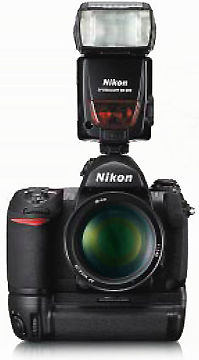 |
* | i-TTL mode: This is a new TTL auto flash mode in the Creative Lighting System. Monitor Preflashes are fired at all times. The subject is correctly exposed by the light from the flash lighting and the exposure is less affected by the ambient light than in the conventional TTL mode. | |
| * | Advanced Wireless Lighting With the Advanced Wireless Lighting, wireless multiple flash operation in the TTL (i-TTL) mode can now be accomplished with digital SLRs. In this mode, you can divide the remote flash units into three groups and control the flash output independently for each group, expanding your range of creative multiple-flash shooting techniques. | ||
| * | Flash Value Lock Flash Value, or “FV,” is the amount of flash exposure for the subject. Using FV Lock with compatible cameras, you can lock in the appropriate flash exposure for the main subject. This flash exposure is locked in, even if you change the aperture or composition, or zoom the lens in and out. | ||
| * | Flash Color Information Communication When the SB-800 is used with compatible digital SLRs, color temperature information is automatically transmitted to the camera. In this way, the camera’s white balance is automatically adjusted to give you the correct color temperature when taking photographs with the SB-800. | ||
| * | Auto FP High-Speed Sync High-Speed flash synchronization at your camera’s highest shutter speed is now possible. This is useful when you want to use a wider aperture to achieve shallow depth of field to blur the background. | ||
| * | Wide-Area AF-Assist Illuminator In autofocus operation, the SB-800 emits AF-Assist illumination over a much wider area as compared to existing Speedlights. This enables you to perform autofocus photography in dim light even when you change the camera’s focus area with cameras supporting this function. |
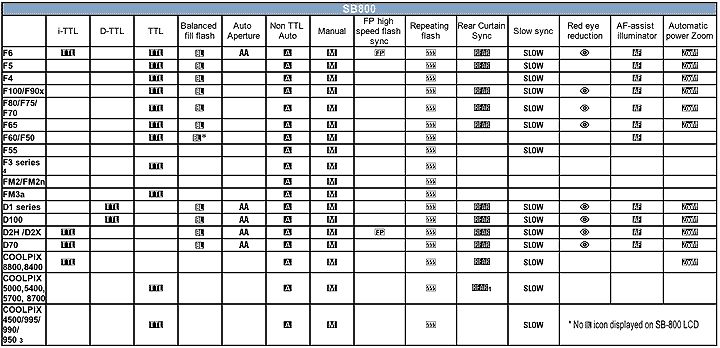 |
Nikon SB-800 Flash / speedlight compatibility chart with various Nikon cameras. |
Supplied accessories: Quick Recycling Battery Pack; Speedlight Stand; Nikon Diffusion Dome; SD-800 AS-19 SW-10H; Colored Gel Filter Set SJ-800; Soft Case SS-800.
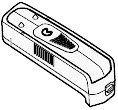 |
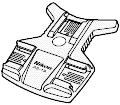 |
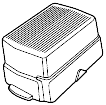 |
 |
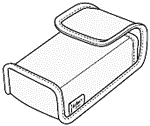 |
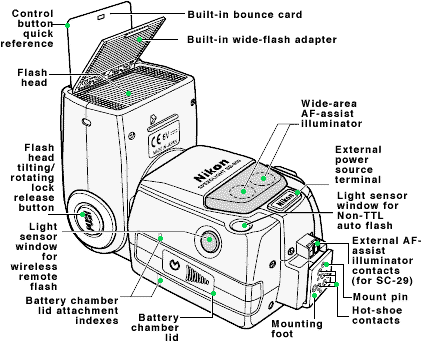 |
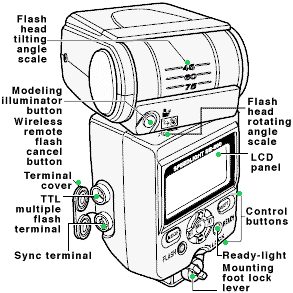 |
Main Reference Map / Nomenclature Nikon Speedlight SB-800 |
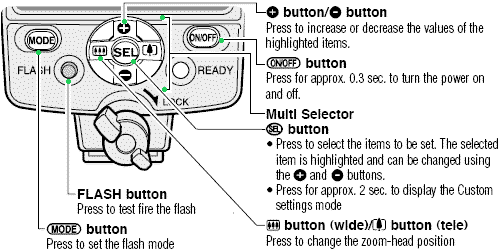 |
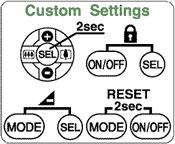 |
Control button quick reference Procedures for Custom settings, recalling the underexposure value in the TTL auto flash mode, resetting all settings to their default values, and the button lock are shown in the Control button quick reference chart on the back of the built-in bounce card. |
The various Icons / symbols appear on the LCD panel: -
Icons on the LCD panel show the status of the operations set. These icons vary depending on the settings, the combination of camera/lens, and the exposure mode.
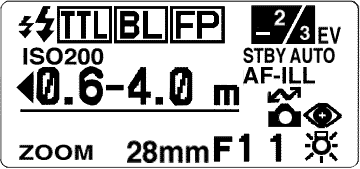 |
Control button quick reference Procedures for Custom settings, recalling the underexposure value in the TTL auto flash mode, resetting all settings to their default values, and the button lock are shown in the Control button quick reference chart on the back of the built-in bounce card. |
1) Icons shown with a single flash unit. Icons when a camera compatible with CLS* is used.
| Monitor Preflashes Just before the flash fires, the SB-800 fires a series of imperceptible preflashes that are detected by the camera’s TTL Multi-Sensor and analyzed for brightness and contrast. | ||
| TTL mode Based on the exposure control information, the camera automatically controls the flash output level to give the correct exposure. | ||
| Balanced Fill-Flash This always appears together with D. Based on the exposure control information, the flash output level is automatically controlled for a well-balanced exposure of the main subject and background. | ||
| Auto FP High-Speed Sync (CLS*) The SB-800 automatically fires at faster shutter speeds exceeding the camera’s sync shutter speed. | ||
| Auto Aperture flash In addition to Non-TTL auto A flash, the SB-800’s built-in sensor correctly controls the flash output in combination with data automatically transmitted from the camera and lens to the SB-800, including the ISO sensitivity, aperture, focal length, and exposure compensation value. | ||
| Non-TTL auto flash The SB-800’s built-in sensor measures the flash illumination reflected back from the subject, controlling the SB-800’s light output automatically to give the correct exposure. | ||
| Distance-priority manual flash Based on the ISO sensitivity value and aperture, the SB-800 controls the light output according to the distance value entered. | ||
| Manual flash The flash always fires at a specified output in combination with the aperture and light output level. |
| Repeating flash The SB-800 fires repeatedly during a single exposure, creating stroboscopic multiple exposure effects. | ||
| Compatible with CLS (CLS*) The SB-800 is connected to cameras compatible with CLS* | ||
| Power zoom function The zoom-head position is automatically adjusted to match the lens focal length | ||
| Manual zoom-head position setting You can adjust the zoom-head position manually. | ||
| Canceling the power zoom function The power zoom is canceled, and the zoom-head position can only be adjusted manually. | ||
| Power zoom function using the built-in wide-flash adapter With the built-in wide-flash adapter attached, the zoom head position can automatically be adjusted. The same is true when the built-in wide-flash adapter is broken off accidentally. | ||
| Underexposure Indicates the underexposure value, showing that the light might be insufficient in the TTL auto flash mode. | ||
| Standby duration Represents the time before the standby function is activated | ||
| ISO / EV | ISO sensitivity Represents the ISO sensitivity value. EV: Flash output level compensation Represents the flash output level compensation value. |
| The wide-area AF-assist illuminator is activated The wide-area AF-assist illuminator comes on. | ||
| The wide-area AF-assist illuminator is canceled The wide-area AF-assist illuminator does not come on. AF-iLL Only Flash firing canceled The SB-800 does not fire but the wide-area AF-assist illuminator still comes on. | ||
| Control buttons being locked Control buttons (except the ON/OFF, Modeling illuminator and FLASH buttons) are locked. | ||
| Red-Eye reduction Red-Eye reduction control is activated. | ||
| LCD panel illuminator Pressing any control button turns on the LCD panel illuminator. | ||
| Beyond the flash-shooting
distance range The subject is beyond the flash shooting distance range. |
2). Icons shown in the LCD panel when used with multiple flash units Icons in the Advanced Wireless Lighting mode
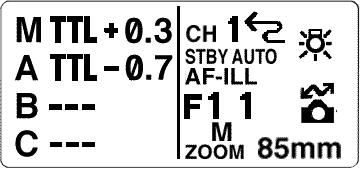 |
|
| Sound monitor on When the SB-800 is set as a remote flash unit, you can monitor its operation by listening to the beeping sound. | ||
| Sound monitor canceled “Beeping” sound is off. | ||
| M Master (CLS*) | Represents the settings of the flash mode and flash output level compensation value of the master unit in the Advanced Wireless Lighting mode. | |
| Group A (B, C) (CLS*) Represents the settings of the flash mode and flash output level compensation value of the remote flash unit(s) in Group A (B, C) in the Advanced Wireless Lighting mode. | ||
| Channel (CLS*) Represents the communication channel number through which the master and remote flash units exchange data in the Advanced Wireless Lighting mode. | ||
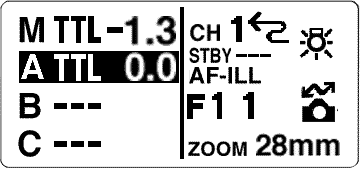 |
Highlighted items |
|
Group |
Camera Model |
TTL auto flash mode |
Non-TTL auto flash mode |
Manual Flash mode |
Wireless Multiple Flash |
|||||||
|
i-TTL |
D-TTL |
TTL |
BL*1 |
auto aperture flash |
non-TTL auto flash |
Distance priority |
manual |
repeating |
Advance wireless Lighting |
Wireless multiple flash |
||
|
Compatible with CLS* |
D2X, D2H |
|
|
|
|
|
|
|
|
|
|
|
|
Digital SLRs not Compatible CLS |
D1-Series, D100 |
--- |
|
|
|
|
|
|
|
|
--- |
|
|
I |
F6, F5, F100, F90X/N90s, F/N90-Series; F/N80-Series, F/N75-Series, F/N70-Series |
--- |
--- |
|
|
|
|
|
|
|
--- |
|
|
II |
F4-Series, F/N65-Series, F-801s/N8008s, F-801/N8008, Pronea 600i/6i |
--- |
--- |
|
|
|
|
|
|
|
--- |
|
|
III |
F-601/N6006, F-601M/N6000 |
--- |
--- |
|
|
--- |
|
|
|
|
--- |
|
|
IV |
F/N60-Series, F/N50-Series, F-401x/N5005 |
--- |
--- |
|
|
--- |
|
|
|
|
--- |
|
|
V |
F-501/N2020, F-401s/N4004s, F-401/N4004, F-301/N2000 |
--- |
--- |
|
--- |
--- |
|
|
|
|
--- |
|
|
VI |
FM3A, FA, FE2, FG, Nikonos V, F3-Series (with the AS-17) |
--- |
--- |
|
--- |
--- |
|
|
|
|
--- |
|
|
VII |
New FM2 (FM2n), FM10, FE10, F3-Series, F/N55-Series |
--- |
--- |
--- |
--- |
--- |
|
|
|
|
--- |
|
*1 ![]() : Balanced Fill-Flash.
This always appears together with
: Balanced Fill-Flash.
This always appears together with ![]() . *2
Wireless multiple flash in the i-TTL mode is possible. *3
TTL mode is not possible. *4 While performing Balanced Fill-Flash,
no
. *2
Wireless multiple flash in the i-TTL mode is possible. *3
TTL mode is not possible. *4 While performing Balanced Fill-Flash,
no ![]() icon appears. *5 Repeating flash is not possible with
the F3-Series (using the AS-17).
icon appears. *5 Repeating flash is not possible with
the F3-Series (using the AS-17).
For other Camera Model(s0 not shown, please CLICK on the respective icon(s) for Group I/II (45k Gif) or Group III, IV, V & VI (43k Gif)
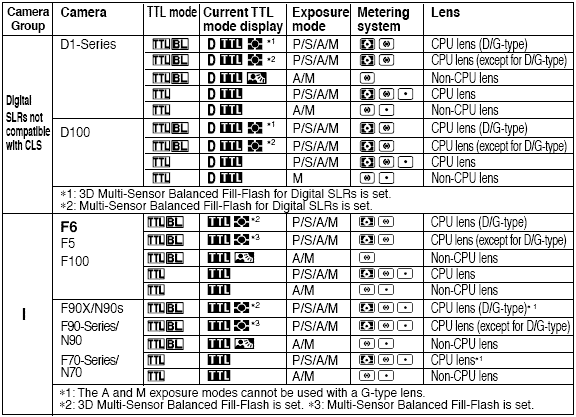 |
|
Lens Type: -
AF-Nikkor lenses are divided into two types: CPU Nikkor lenses and non-CPU Nikkor
lenses.

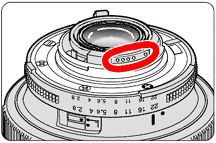 |
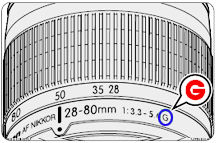 |
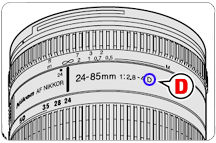 |
|
CPU lenses CPU lenses
have CPU contacts.
D-type Nikkor lenses D-type Nikkor lenses send distance information to the
camera body. Set the aperture either on the lens aperture ring or on the camera body.
G-type Nikkor lenses G-type Nikkor lenses send distance information to the camera
body, but do not have an aperture ring. Therefore, set the aperture on the camera
body. With some cameras, the usable exposure mode is limited.
Basic operation: basic
procedures are described when a CPU lens is mounted on cameras compatible with CLS*,
digital SLRs not compatible with CLS*, and cameras in Groups I to II. The SB-800’s
available functions and the LCD display vary depending on other camera/lens combinations.
Usable batteries: four AA-type penlight batteries (1.5V or lower) of any of these
types: (1) Alkaline-manganese (1.5V) (2) Lithium (1.5V) (3) Nickel (1.5V) (4) NiCd
(rechargeable, 1.2V) (5) Ni-MH (Nickel Metal Hydride) (rechargeable, 1.2V). When
replacing batteries, replace all four (or five when using the Quick Recycling Battery
Pack SD-800) with fresh ones of the same brand. Note: High-power manganese batteries
are not recommended for use with the SB-800.
Obtaining faster recycling times using 5 batteries: Use the provided Quick Recycling
Battery Pack SD-800 to install five batteries to shorten the recycling time.
External power sources Using an optional external power source increases the
number of flash firings and provides faster recycling times
Minimum number of flashes and recycling times When using four (or five) fresh
batteries of the same type and the Speedlight fires at M1/1 output.
 |
Replacing/recharging the batteries Refer to the following table to determine when to replace or recharge your batteries, if the ready-light takes a long time to come on. |
| previous | NEXT | 1/6 flash head, available flash modes, Monitor Preflashes, TTL auto flash mode & Non-TTL auto flash mode
Index Page | Page Two | Page Three | Page Four | Page Five | Page Six |
| Back | Index Page - Nikon Flash Photography with Nikon F5
Relative:
Nikon AF-TTL Speedlight Models: Nikon
SB-800 | Nikon
SB-600
| Nikon SB-30
| Nikon
SB-29(s)
(2000) | Nikon SB-28 (1997) |
Nikon
SB-27 (1997)
| Nikon
SB-26
(1994) | Nikon SB-25 (1992) |
Nikon
SB-24 (1988) |
SB-23 | SB-22
(1987) |
SB-20 (1986)
Nikon AF-TTL Speedlight DX-Series: Nikon SB-28DX (1999)| SB-50DX (2001) |
SB-80DX (2002)
Additional information on various Nikon MF Bulb Flash - Nikon MF-Speedlights
SB-1 ~ SB-21A/B
| Back | Main Index Page - Nikon F5 Professional SLR camera
The Camera - Background,
Issues & Summary
Basic
Features | Focusing | Metering Systems | Exposure Control | Reliability Issues | Nikkor lens Compatibility
Prisms/Finders - Index page
- 2 parts
Film Backs: Index
Page - 1 parts
Focusing Screens - Index Page
- 1 part
Flash System - Index
Page
- 3 parts
System Accessories: | Power Sources | Cases | Remote
Control | Miscellaneous
Macro
Photography
- Related info on Micro-Nikkor lenses
Technical Specification for Nikon F5
Main
Reference Map
/ Nomenclature
Resource Centre:
Instruction Manuals
Nikon
F5 Camera Body
- 18
parts
MF-28
Multi-Function Back
HTML - 8
parts
PC
Links - Photo Secretary
- 2
parts
AF-TTL Speedlights:
SB-28 / SB28DX | SB29(s) info | SB30 | SB50DX | SB80DX | SB600 info | SB800
Variants: F5 50th Anniversary Model | Nikon/Kodak DCS-620 | DCS-720 Digital Still SLR camera
| Back | Index Page of Digital
Nikon SLR cameras
|
Back | Main Index Page of Pictorial
History of Nikon SLR cameras
![]()
| Nikon F | Nikon F2 | Nikon F3 | Nikon F4 | Nikon F5 | Nikon F6 | Nikkormat / Nikomat | Nikon FM | Nikon FE/ FA | Nikon EM/FG/FG20 | Nikon Digital SLRs | Nikon - Other models |
The Eyes of Nikon:-
Nikon Auto Focus Nikkor lenses:- Main
Index Page
Nikon Manual Focus Nikkor lenses:- Fisheye-Nikkor Lenses - Circular | Full Frame |
Ultrawides Lenses - 13mm15mm18mm20mm | Wideangle Lenses - 24mm28mm35mm | Standard Lenses - 45mm 50mm 58mm | Telephoto
Lenses - 85mm105mm135mm180mm & 200mm | Super-Telephoto Lenses - 300mm 400mm 500mm 600mm 800mm 1200mm |
 Index Page |
Special
Application lenses: Micro-Nikkor Lenses - 50mm~55mm -60mm 85mm -105mm 200mm Micro-Zoom 70-180mm Perspective Control (PC) - 28mm 35mm PC-Micro 85mm Dedicated Lenses for Nikon F3AF: AF 80mm f/2.8 | AF 200mm f/3.5 EDIF Depth of Field Control (DC): 105mm 135mm Medical Nikkor: 120mm 200mm Reflex-Nikkor Lenses - 500mm 1000mm 2000mm Others: Noct Nikkor | OP-Nikkor | UV Nikkor 55mm 105mm | Focusing Units | Bellows-Nikkor 105mm 135mm Nikon Series E Lenses: 28mm35mm50mm100mm135mm | E-Series Zoom lenses: 36~72mm75~150mm70~210mm |
MF Zoom-Nikkor Lenses: 25~50mm | 28~45mm | 28~50mm | 28~85mm | 35~70mm | 36~72mm E | 35~85mm | 35~105mm | 35~135mm | 35~200mm | 43~86mm | 50~135mm | 50~300mm | 70~210mm E | 75~150mm E | 80~200mm | 85~250mm | 100~300mm | 180~600mm | 200~400mm | 200~600mm | 360~1200mm | 1200~1700mm
Tele-Converters: TC-1 | TC-2 | TC-200 | TC-201 | TC-300 | TC-301 | TC-14 | TC-14A | TC-14B | TC-14C | TC-14E | TC-16 | TC-16A | TC-20E
Recommended links to understand more technical details
related to the Nikkor F-mount and production Serial Number:
http://rick_oleson.tripod.com/index-153.html by: my
friend, Rick Oleson
http://www.zi.ku.dk/personal/lhhansen/photo/fmount.htm by: Hansen,
Lars Holst
http://www.mir.com.my/rb/photography/hardwares/nikonfmount/lens2.htm
http://www.photosynthesis.co.nz/nikon/serialno.html
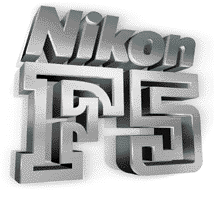 |
| Message Board | for Nikon F5 Series SLR model(s) | |
About this photographic site.
HOME - Photography in Malaysia |
![]()
A resource dedicated to my kids, Alvin Foo & Esther Foo- one day,
BOTH might need to use all these information for his/her Nikon F5A camera.
Volunteered Maintainer(s) for the Nikon F5 Message Board: Tony Davies-Patrick, UK; Rick Oleson, US; Koh Kho King, Malaysia.
Credit: Mr. Chuck Hester, US for his text re-editing skill for this site; Our staff, HowKiat® who created the 3D-Nikon F5 logo. Mr. Lew Chee Wai of YL camera for lending his F5 for me to take some shots appeared in this site. All those nice folks who have contributed their images, in particular Mr. Mike Long, Edwin leong, Palmi Einarsson, Sergio Pessolano, Fred Kamphues, Harry Eggens, Curtis Forrester, Nick (Natures Moments), Sandra Bartocha; fellow countrymen, Vincent Thian, Koh Kho King, Philip Chong, CY Leow etc. and contributions from a few nice folks from Photo Malaysia Forum. Disclaimers & acknowledgments: Certain content and images appeared in this site were either scanned from official marketing leaflets, brochures published by Nikon and/or contribution from surfers who claimed originality of their own work for public publishing in this website, where majority of the extracted information are used basing on educational merits. The creator of this site will not be responsible for any discrepancies that may arise from any possible dispute except rectifying them after verification from respective source. Neither Nikon or its associates has granted any permission(s) in using their public information nor has any interest in the creation of this site. "Nikon", "Nikkormat", "Nippon Kokagu KK" "Silent Wave", "Focus Tracking Lock-on", "Nikkor" & other applicable technical/business terms are registered trade name(s) of Nikon Corporation Inc., Japan. Site made with an Apple G5 IMac.
